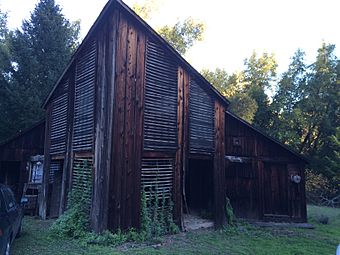Pond Farm facts for kids
Pond Farm was a special place where artists lived and worked together. It was also known as Pond Farm Workshops. It started in the 1940s and continued until 1985. You can find it near the Russian River in Guerneville, California. This is about 75 miles (120 km) north of San Francisco.
Pond Farm is on a hilltop, 600 feet (180 m) above the Armstrong Redwoods State Reserve. It began around 1939-1940. A couple from San Francisco, Gordon and Jane Herr, bought the land. Gordon was an architect and Jane was a writer. They first bought 250 acres (1.0 km2), and later expanded it to 400 acres (1.6 km2). Because there was a large pond on the property, the Herrs named it Pond Farm. It has two small homes and an old barn that became a pottery studio.
Contents
What Were the Pond Farm Workshops?
The Herrs wanted Pond Farm to be a community for artists. They were inspired by famous art schools like the Bauhaus and Cranbrook Academy of Art. They hoped the summer workshops would help support the community. Gordon Herr saw Pond Farm as a "safe place for artists" away from a busy world. Jane Herr saw it as a new start.
The Herrs were good at farming. They raised many different animals. They also planted fruit trees, nut trees, and vegetable gardens. They even created several fish ponds.
Finding Artists for Pond Farm
In 1939, Gordon Herr traveled to Europe. He wanted to find artists who would fit well with his ideas. In the Putten, Netherlands, he met Frans and Marguerite Wildenhain. They were potters who ran a shop called Het Kruike (Little Jug). Both had studied pottery at the Weimar Bauhaus in Germany.
Herr invited them to move to the U.S. and join Pond Farm Workshops. The Wildenhains were not sure at first. But six months later, when the Nazis invaded Poland, they asked Herr if his offer was still open. It was! Marguerite left for the U.S. on March 3, 1940. Her husband, Frans, could not come yet because of immigration rules. Marguerite was Jewish, and Frans was not.
Marguerite Wildenhain at Pond Farm
Marguerite Wildenhain eventually came to California. After looking at other options, she decided to join the Herrs at Pond Farm Workshops. She moved there in 1942. She helped set up water lines and started a garden. She also built a house. Working with Gordon Herr, she fixed up and redesigned a barn. This barn became her pottery workshop.
Later, in 1949, the Herrs started building a new place called the Hexagon House. It was near the entrance of the Armstrong Redwood Forest. This building was for students to live and eat. It was also a place for public gatherings.
Who Were the Resident Artists?
Marguerite Wildenhain was the first artist to join Pond Farm Workshops. In 1947, her husband, Frans Wildenhain, joined them. He had been separated from Marguerite for seven years because he was in the German Army during World War II. Frans taught sculpture.
In 1949, two more European artists joined the community. Trude Guermonprez taught weaving, and Victor Ries taught metalwork. Gordon Herr taught architecture, and Jane Herr helped manage the business. Other artists also visited and taught, including Jean Varda (collage), David Stewart (sculpture and pottery), Claire Falkenstein (painting), Lucienne Bloch (fresco), Stephen Dimitroff (fresco), and Harry Dixon (metals).
Why the Workshops Ended
The first summer workshop likely happened in 1949. Sadly, the workshops closed just a few years later in 1953. The artists were very strong-willed, which helped them survive the war. But these strong personalities also led to disagreements. This caused the group to break apart.
Pond Farm Pottery School
When Pond Farm Workshops closed in 1953, most artists left. But one artist stayed: Marguerite Wildenhain. She was a potter from the Bauhaus school. She continued to run a school and workshop on the site called Pond Farm Pottery. She taught there until 1980.
Wildenhain was known for teaching very carefully. New students had to start by making simple dog dishes. They learned all the steps of throwing pottery before moving to harder projects. One of her students was Dean Schwarz, who later started South Bear School. He studied at Pond Farm in the 1960s. Dorothy Bearnson, an art professor, also took seven summer workshops with Wildenhain between 1947 and 1964.
State Ownership of Pond Farm
As early as 1963, the State of California wanted to buy Pond Farm. They used a power called "eminent domain" to buy the property. This was to expand the Austin Creek State Recreation Area. Gordon Herr had to move. But because her students asked, Marguerite Wildenhain was allowed to live on the property until she passed away.
Pond Farm's Historic Status
When Marguerite Wildenhain died in 1985, her property became part of the Austin Creek State Recreation Area. In 2013, the site received money to help fix up the house and barn. The National Trust for Historic Preservation has called Pond Farm a "National Treasure."
The Pond Farm complex was added to the National Register of Historic Places in 2014. This means it is an important historical site in the United States.
See also
 In Spanish: Pond Farm para niños
In Spanish: Pond Farm para niños


